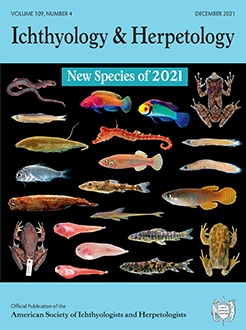Distinct morphological differences between and within sexes may reflect reproductive behaviors that have evolved under natural and sexual selection. In some members of the Eurycea bislineata (Two-Lined Salamander) species complex, inter- and intrasexual variation in head morphology result from secondary sexual characters used in locating, courting, and guarding mates. In populations of Eurycea cf. wilderae (Blue-Ridge Two-Lined Salamander), males possess one of two suites of morphological traits corresponding to alternative reproductive tactics. “Searching” males appear to be adapted for locating and courting females in terrestrial habitats and are characterized by the seasonal development of mental glands, protruding premaxillary teeth, and elongate cirri. “Guarding” males appear to be adapted for aggressively guarding females in aquatic habitats, lack all three aforementioned traits, and are instead characterized by seasonally enlarged jaw musculature. Traditionally, males have been categorized by treating these traits as binary (i.e., present or absent), but this fails to capture any continuous variation. Here, we evaluated the utility of geometric morphometric methods to quantify and describe differences in head morphology among female, searching male, and guarding male E. cf. wilderae. In the left-lateral view, we found significant pairwise differences among all three morph–sex groups. In the ventral view, we found significant pairwise differences between searching males and guarding males and between searching males and females, but not between guarding males and females. Deformation grids clearly demonstrated the enlarged jaw musculature of guarding males and wider, flatter rostrum of searching males. Our results demonstrate utility of geometric morphometric methods for describing head shape differences among these alternative reproductive tactics and provide baseline data for future studies of spatial and temporal variation.
BioOne.org will be down briefly for maintenance on 17 December 2024 between 18:00-22:00 Pacific Time US. We apologize for any inconvenience.
How to translate text using browser tools
2 November 2021
Quantifying Inter- and Intrasexual Head-Shape Polymorphism in Eurycea cf. wilderae (Blue-Ridge Two-Lined Salamanders)
Howard N. Rainey,
Todd W. Pierson,
Jennifer Deitloff
ACCESS THE FULL ARTICLE

Ichthyology & Herpetology
Vol. 109 • No. 4
December 2021
Vol. 109 • No. 4
December 2021




